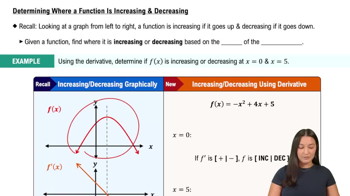Locating extrema Consider the graph of a function ƒ on the interval [-3, 3]. <IMAGE>
c. Give the approximate coordinates of the inflection point(s) of f.
 Verified step by step guidance
Verified step by step guidance Verified video answer for a similar problem:
Verified video answer for a similar problem:



 5:58m
5:58mMaster Finding Extrema Graphically with a bite sized video explanation from Patrick
Start learning